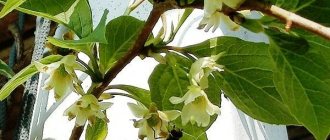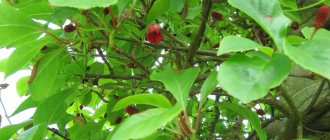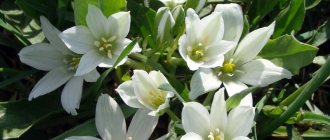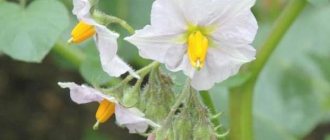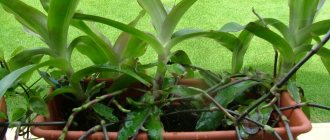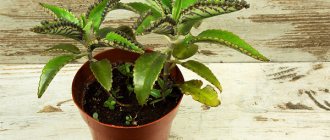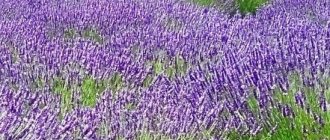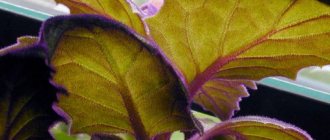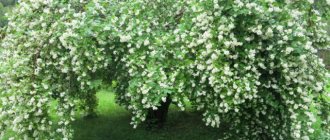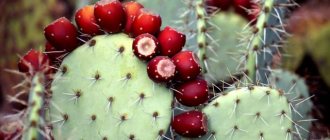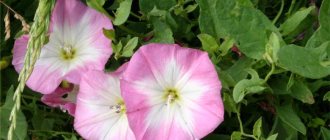Botanical description
The leaves are 10 cm in size. They are pointed at the top and have a wedge-shaped base at the bottom. The surface of the foliage is glossy, the color is dark green.
The flowers look attractive. When fully expanded, they acquire a pinkish tint. In good conditions for growing lemongrass, you can get a lot of berries that taste good. Each fruit is red in color. The fruits can be used to prepare preserves and jams.
The tree blooms in the last May - first June weeks. The culture is pleasing to the eye for 14 days. The berries are fully ripened at the end of September.
Jams, jelly and soft drinks are prepared from lemongrass fruits. The taste of berries as a candy filling is original. The leaves and bark are used to make aromatic tea.
Reproduction methods
My friends advise propagating lemongrass by dividing the bush. Seed propagation is rarely practiced, but we will still consider it.
- In the spring, the seeds are collected and separated from the seedlings before sowing into a fertile substrate. Seeds undergo stratification for 2 months and should be kept under film.
- Shoots will appear 15 days after sowing in the soil substrate; they will need to be placed in a lighted place. Sprouts should not be exposed to sunlight.
- For speedy germination, it is necessary to treat the crops with a weakly concentrated solution of potassium permanganate.
- After some time, the seedlings will form 3 leaves; you will need to plant them in larger boxes.
Seedlings benefit from hardening: keep them at room temperature and periodically ventilate the room.
Open the window for a few minutes and increase the ventilation time daily. When planting, maintain a distance between specimens: it should be about 15 cm. You will see seedlings in 3 years.
Manifold
Species and varieties of lemongrass are not represented in such large quantities as other crops. The following are popular:
A self-pollinating, highly productive winter-hardy variety is Sadovyi-1. The tree grows spherical, juicy and sour berries that are red in color and have a rather aromatic lemon smell. They are collected in brushes.
The Mountain variety is distinguished by its originality. It is characterized by winter hardiness, productivity, high resistance to the development of diseases and the influence of insect pests. The fruits ripen in September.
The Volgar variety is winter-hardy and drought-resistant. It withstands the effects of diseases and pests. The berries are tasty and juicy.
The fruits of the Pervenets variety look original. The tree can withstand fairly low temperatures and does not require insulation or covering for the winter. The taste of berries attracts the attention of many children and adults.
Myth looks amazing. The variety belongs to hybrids. The berries have a tart taste. They are equally readily used fresh and in compotes. Experts note its high resistance to sub-zero temperatures, the development of dangerous diseases and insect pests. Gives a high yield every year.
There are some other varieties, but they grow quite rarely in gardens.
Schisandra blooms, but does not bear fruit. Capricious liana. Why doesn't lemongrass bear fruit?
Wrong gender?
Do you think there are only two genders - male and female? Plants also have other options. So, lemongrass is divided into four different groups.
"Men". They are firmly determined with their sexual orientation from the moment of the first flowering and do not change it throughout their lives. They don't produce fruit.
"Women". Only female flowers form and then berries (if lemongrass with male flowers grows nearby).
Plants with alternating sexes: the same vine (perhaps depending on the mood?) produces only male flowers one year, only female flowers the next, and so on. The harvest is unpredictable.
Monoecious vines, which in their youth can feel like “men” and bloom only with male flowers, but in subsequent seasons form male and female flowers. They are able to bear fruit alone and deserve special attention from summer residents. This valuable group includes the Pervenets and Debut varieties, selected in the Moscow region from Far Eastern seeds.
Dense shadow?
In order for lemongrass to bear fruit, it needs to receive direct sunlight for at least half the day. If it is planted in dense shade, then there will be no fruit until the vine reaches the light.
Photo: From personal archive/Natalia Kozak
Didn't you watch the density?
Schisandra produces a lot of shoots. If it is allowed to do this without restrictions, it will expand indefinitely, remaining stunted, and there will be little fruit. Therefore, all excess annual offspring must be removed. Schisandra fruits best if it is formed on a support of 2-3 stems and grows upward, not outward.
Shoots - for planting
Excess shoots can be planted in a new place. True, in this case it must be separated from the mother plant before buds open or after leaf fall. The shoots dug up with leaves suffer greatly after transplantation and may die even if there are high-quality roots.
Bad spring?
Schisandra flowers are pollinated not by bees, but by small pollen-eating beetles. In cold or rainy weather, they may not be able to cope with their duties.
4 reasons to grow lemongrass
- This is a picturesque winter-hardy vine that will decorate a hedge, gazebo, trellis or pergola.
- It produces fruits with an unusual taste, which simultaneously contains sour, sweet, spicy, acrid, balsamic and even salty notes. But those who once tasted lemongrass will love it all their lives.
- Fruits or tea with lemongrass leaves invigorate and improve your mood.
- It is easy to care for.
The benefits of culture
Already in ancient times, people noted the beneficial properties of lemongrass. It was used in the following cases:
- to boost the immune system to prevent the development of dangerous viral infections;
- berries normalize the acidity of gastric juice;
- eliminates fatigue;
- increases blood pressure;
- relieves asthma;
- allows you to cope with significant mental or physical stress;
- prevents the development of respiratory system diseases.
Varieties, varieties
There are several popular types.
- Chinese. The maximum height of a woody plant is 10 m. The leaves have a darkish color, their length, as a rule, does not exceed 9 cm. Chinese lemongrass is distinguished by large pinkish flowers, 1 piece in diameter. — 14 cm. The tree begins to bloom in May.
- Crimean. The plant is found in Crimea; gardeners value it for its resistance to cold. Crimean lemongrass, like other species, prefers sunny beds. The leaves of this plant are used in cooking and aromatic drinks are brewed from them. The plant is low-growing, its maximum height is 75 cm.
- First born. This is not a species, but a variety, its maximum size is 1.9 m. The advantage of the tree is that it is resistant to cold and temperature changes. Its fruits are small and ripen in August.
- Sadovyi-1. This variety is often cultivated in the middle zone. The plant is presented in the form of a tall vine, its leaves are rich green, emit a characteristic lemon aroma, and the fruits are sour.
Schisandra (Schisandra) is a deciduous (less often evergreen) plant - a liana belonging to the Limonnikov family. In nature, there are about 23 varieties of it, among which there are ornamental and medicinal plants.
Contraindications
There are cases when lemongrass cannot be used in any form. Avoid using the product if the following pathological processes develop:
- in cases of arterial hypertension development;
- with increased excitability;
- with vegetative-vascular dystonia;
- with the development of increased intracranial pressure;
- for allergic reactions;
- when arachnoiditis appears;
- with epileptic manifestations;
- for problems with sleep;
- in a state of pregnancy;
- in case of acute infectious disease.
He also recommends not eating lemongrass berries if a person develops kidney or liver pathologies. This will lead to aggravation of the condition. It is better to consult a doctor if various pathological processes develop.
Use in folk medicine
With the help of Chinese lemongrass, many diseases are treated. Some of them:
- Overwork.
- Infectious diseases.
- Diseases of the gastrointestinal tract.
- Respiratory diseases;
- Anemia.
- Infertility.
- Hepatitis C.
- Enuresis (urinary incontinence).
You can begin treatment with lemongrass by preparing decoctions of not only the fruits, but also the seeds. To strengthen the immune system, you can prepare a tincture with alcohol. To do this, infuse 10 g of fresh fruits in 50 ml of alcohol (70%) for about 10 days. After this, the tincture can be filtered through cheesecloth, and the berries can be filled with alcohol again for 10 days.
Important! Schisandra berries should be consumed in small portions and not often, otherwise side effects may occur, such as insomnia, allergies, hypertension, etc.
Both tinctures are mixed, diluted with water, doubling the volume, and consumed 20 drops 2 times a day before meals. But despite all the positive qualities of the plant, there are also contraindications. For example, it is prohibited to use it for hypertension, tachycardia and acute gastritis.
How to plant lemongrass and care for it
When to plant lemongrass, each gardener decides for himself. This can be done in spring or autumn. Only in the latter case is it necessary to plant the plant in the soil at such a temperature that it takes root. If lemongrass is planted in the garden in frosty weather, the seedling will die.
Select well-lit areas for seedlings. The soil should be loamy, slightly acidic.
Although the culture is quite unpretentious, it grows and develops better if the necessary care is provided. The soil around the seedling should be loosened. This will attract enough air to the roots, allowing them to grow better.
The seedling has enough strength to feed itself. The roots are able to pull all the necessary substances from the soil. The seedling should be fed several times. The procedure is performed before the start of active vegetative growth, during flowering, and also after fruiting. This will allow the crop to produce a bountiful harvest every year.
In hot weather, the seedling should be watered. It also responds well to spraying. The procedure is carried out using settled water for 24 hours. Otherwise, the tree may get sick.
Schisandra pruning is also necessary. The procedure is carried out by specialists in late autumn. To do this, cut the stems, leaving 15-20 centimeters of shoots. A sufficient number of buds are left on each. If necessary, pruning is repeated in the spring.
To cope with pests and diseases of lemongrass, the tree should be treated with special preparations. To carry out the procedure, various means are used, which are widely represented in the store chain. The use of drugs should be avoided at the time of fruiting, as the berries will accumulate toxins and become dangerous to human health.
To prevent weeds from growing around the lemongrass, mulch the surface with a special material. This will reduce labor costs.
Schisandra is an excellent fruit-bearing tree. It produces a bountiful harvest with minimal care, which consists of regular loosening, pruning, and treatment against diseases and insect pests.
Composition and beneficial properties
This plant has long been known to both official medicine and herbalists. Interestingly, the entire above-ground part of the plant is suitable for harvesting and harvesting.
Already in early spring, when the leaves first bloom, they can be collected and dried for further use in the form of tea. This tea drink, made from aromatic leaves, has a delicate lemon flavor and is useful for scurvy.
All other parts of the vine are harvested in the fall. In autumn, branches are pruned and harvested.
After harvesting the fruits, they are dried or juiced. The bark and stems are cut into pieces and dried, but the seeds are obtained only after processing.
After squeezing the juice, a cake with lemongrass seeds remains, which is left to ferment. The seeds, after being washed from the cake and dried, are ready for the preparation of various medicines.
The final ripening of the fruits occurs in early September, but they can hang until frost without losing their unique properties.
The full composition of microelements, organic acids, vitamins makes this plant very effective in the treatment of such diseases:
- Hypotension (low blood pressure);
- Rehabilitation after infectious diseases;
- Heart failure and lung diseases;
- Imbalance of sexual function due to neurasthenia;
- Inhibition of excitation of the cerebral cortex;
- Fatigue from mental and physical overload.
All of these diseases are treated with the help of Schisandra chinensis, which successfully combines multifaceted usefulness and decorative beauty.
It is difficult to find another plant in nature that would combine all these functions.
